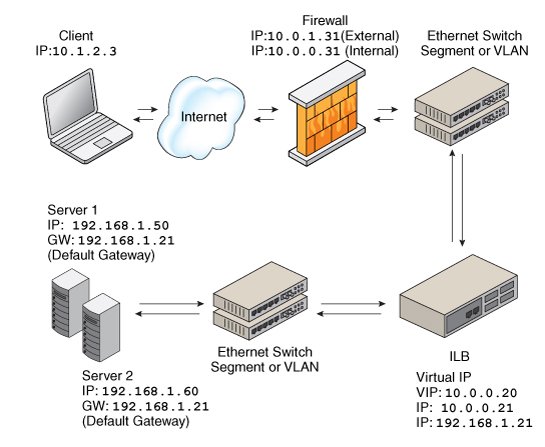Network Address Translator Mode
ILB uses NAT in stand-alone mode strictly for load-balancing functionality. In this mode, ILB rewrites the header information and handles the incoming as well as the outgoing traffic. ILB operates in both the half-NAT and full-NAT modes. However, full-NAT also rewrites the source IP address, making it appear to the server that all connections are originating from the load balancer. NAT does provide TCP connection tracking (meaning that it is stateful). The NAT mode provides additional security and is best suited for Hypertext Transfer Protocol (HTTP) or Secure Sockets Layer (SSL) traffic.
-
Works with all back-end servers by changing the default gateway to point to the load balancer
-
Adding or removing servers without connection disruption is possible because the load balancer maintains the connection state
-
Slower performance than DSR because processing involves manipulation of the IP header and servers send responses to the load balancer
-
All the back-end servers must use the load balancer as a default gateway
The general implementation of the NAT mode is as shown in the following figure.
Figure 5-2 Network Address Translation Topology

In this case, all requests to the VIP go through the ILB and are forwarded to the back-end servers. All the replies from the back-end servers pass through the ILB for NAT.
 | Caution - The NAT code path that is implemented in ILB differs from the code path that is implemented in the IP Filter feature of Oracle Solaris. Do not use both these code paths simultaneously. |
Half-NAT Load-Balancing Mode
In the half-NAT mode of the ILB operation, ILB rewrites only the destination IP address in the header of the packets. If you are using the half-NAT implementation, you cannot connect to a VIP address of the service from the same subnet on which the server resides. The following table shows the IP addresses of the packets flowing between the client and ILB, and between ILB and back-end servers.
|
If you connect the client system to the same network as that of the servers, the intended server responds directly to the client, and the fourth step in the table does not occur. Therefore, the source IP address for the server response to the client is invalid. When the client sends a connection request to the load balancer, the response occurs from the intended server. From this point onwards, the IP stack of the client correctly drops all the responses. For this scenario, the request flow and response flow proceed as shown in the following table.
|
Full-NAT Load-Balancing Mode
In the full-NAT implementation of the ILB operation, the source and destination IP addresses are rewritten to ensure that the traffic goes through the load balancer in both directions. The full-NAT mode makes it possible to connect to the VIP from the same subnet that the servers are on.
The following table depicts the IP addresses of the packets flowing between a client and ILB, and between ILB and a back-end server by using the full-NAT mode. No special default route using the ILB box is required in the servers. Note that the full-NAT mode requires the administrator to set aside one IP address or a range of IP addresses to be used by ILB as source addresses to communicate with the back-end servers. Assume that the addresses used belong to subnet C. In this scenario, ILB behaves as a proxy.
|